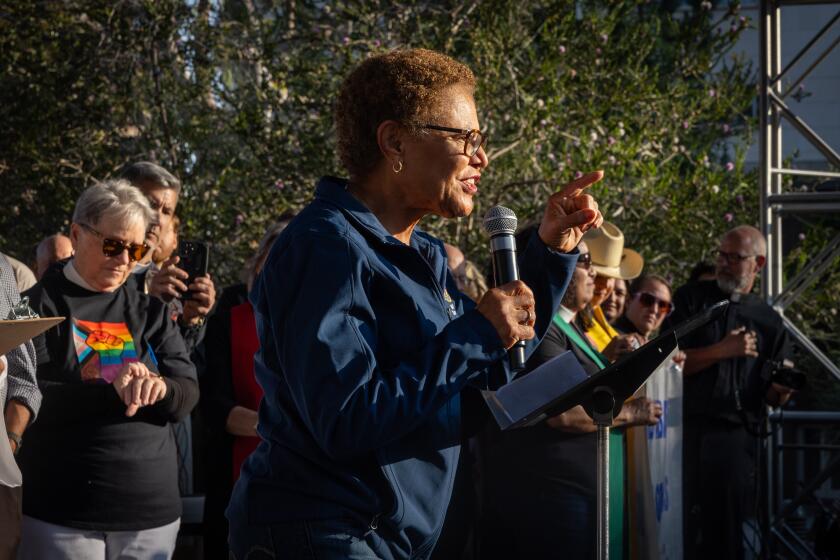Memorial March
- Share via
CANOGA PARK — In 1942, the first thing Takuro S. Nakae did when he was released from a Japanese American internment camp was enlist in the U.S. Army.
On Monday, Nakae, 77, stood with an estimated 30,000 people along Sherman Way and Canoga Avenue to watch the 12th annual Canoga Park Memorial Day Parade wend its way past pawnshops, fast-food restaurants and strip malls.
“Internment was very disappointing,” he said. “But on the other hand, I was still an American.” So as soon as the U.S. government declared him eligible, Nakae signed up to become an Army engineer.
Like Nakae, now a Winnetka resident who attends every year, many of the parade watchers were immigrants. The parade featured two announcers: one English-speaking, the other Spanish. Salsa music and rock ‘n’ roll blared alternately out of crackling speakers.
The Canoga Park parade is a low-tech affair--some of the floats featured nothing more than boats on trailers pasted with colored paper. The marching bands were small and largely devoid of drums.
Patrick Murphy, who founded the parade in the 1980s, said he hoped it would honor the men and women who fought in the U.S. Armed Forces and raise Canoga Park’s profile. With its collection of motor inns, auto body shops and thrift stores, Murphy acknowledged that Canoga Park is a far cry from places like Old Pasadena, the home of the Rose Parade.
“But we’re trying to overcome all of that,” he said.
Among the dignitaries present were Los Angeles County Supervisor Zev Yaroslavsky, City Councilwoman Laura Chick and Armand Kay, a 58-year-old Elvis impersonator with a French accent and a rhinestone-studded jumpsuit.
A flyover by a squadron of vintage fighter planes kicked off the parade. The Boeing Co. entered one of the showiest floats, a model space shuttle pointing toward the sky. But the crowd favorite may have been a firetruck that stopped near the Madrid Theater to hose down a bunch of kids in the 94-degree heat.
Down the road from Nakae stood Ret. Master Sgt. Edward Figueroa, 80, who was born in Mexico but grew up in East Los Angeles. He tried to enlist in the U.S. military after Japanese bombers attacked Pearl Harbor, but he was rebuffed.
“I felt like an American,” he said. “But I wasn’t a citizen.”
As the war dragged on, however, the U.S. became more willing to allow new immigrants like Figueroa to serve, and eventually he received a letter inviting him to join the military. He did, and Figueroa, one of the only Latino soldiers in his air unit, said he flew 63 missions over Germany as a radio operator and a gunner aboard a B-26 Marauder.
On Monday, Figueroa decorated his cap with his many ribbons and three battle stars. On the breast of his crisp short sleeve shirt was the insignia of the 319th Bombardment Group.
“I was one of the lucky ones,” he said, recounting a time the Germans shot up the landing gear and forced his crew to crash-land in Italy. On another mission, his bomber was swarmed by German fighters. Figueroa later discovered his saviors were the Tuskegee Airmen, among the only black World War II Air Force pilots to see combat.
Richard Tran, 37, was a different kind of veteran. He was 5 years old when the Viet Cong launched the Tet Offensive and set his house on fire. “My family was selling gasoline,” he said.
Sitting with his wife and daughter on a patch of grass as the parade passed, Tran recalled how his family waited in the burning house until the more lethal threat--the Viet Cong--had left. Now he lives in Canoga Park and has been an American citizen since 1983. He’s worked for NASA and Hughes Aircraft, where he helped design a chip for the U.S. F-15 jet fighter. He comes to the parade every year.
“I appreciate what the U.S. soldiers have done,” he said.
Don Stout, 82, who rode through the parade in a convertible outfitted by the Canoga Park Elks, was a B-17 bomber pilot during World War II and was shot down over the north coast of Germany.
Stout and four others escaped the moribund plane, but five others were cut to pieces by swooping German fighters.
Stout was captured by the Germans and imprisoned for 28 months. By the time Allied troops occupied Europe, Stout weighed 120 pounds, down from 180.
“I still fly the American flag,” he said. “I think we should fly it every time we get a chance.”
* RELATED STORY: B11
More to Read
Sign up for Essential California
The most important California stories and recommendations in your inbox every morning.
You may occasionally receive promotional content from the Los Angeles Times.












